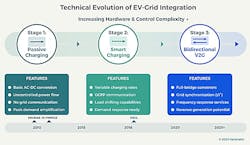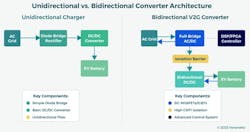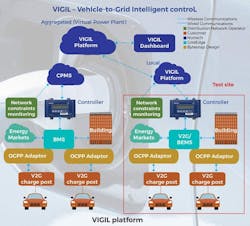Bidirectional EV Charging Plugs into the Grid
Today, electric vehicles (EVs) have more in common with grid-scale energy storage than traditional cars. They’re evolving into complex, software-defined energy platforms, equipped with advanced computing, connectivity, and grid-interaction capabilities that extend their role beyond transportation.
This shift takes on more importance when considering how to integrate millions of EVs into aging electrical infrastructure. The challenge is significant: In the U.K., for instance, a typical residential street with 30 homes might draw 100 to 150 kW in the evening during peak charging times. If even a third of these households charged EVs simultaneously at 7 kW, you’re potentially doubling the local power demand, requiring a major upgrade to power distribution networks.
Yet this challenge conceals a big opportunity, too. By early 2025, the U.K. surpassed 1 million battery-powered EVs for the first time. With average power capacities approaching 45 kWh per car, that represents approximately 63 GWh of distributed energy storage — more than 18X the dedicated grid-scale battery storage available in the country, which is estimated to be about 3.5 GWh today.
The question becomes: “How can we harness this massive, distributed resource?” That raises a related question: “How can we do that while ensuring grid stability and rewarding consumers for giving back to the grid?
The solution lies in the technical progression from traditional passive EV charging systems to more advanced smart chargers that can respond to varying conditions in the electric grid and dynamically adjust charging rates. In the future, the plan is to shift to bidirectional charging systems that can even return power to the grid.
At Versinetic, we’ve been exploring these technologies since 2010, and since then, we’ve been building controller boards for several generations of EV charging systems, including the chargers installed at the London Olympics in 2012. One of the more recent developments was the VIGIL project: Working with a wide range of industry partners, we helped develop the first end-to-end vehicle-to-grid (V2G) system in the U.K.
Let's examine the technical differences between these approaches and why they matter for the future of the electric grid.
What are the Differences Between EV Charging Architectures?
Instead of following a traditional “use it when you need it” model, smart charging is all about flexibility. Most vehicles sit parked for over 90% of their lives, providing an extensive window to shift electricity consumption to optimal periods.
At the heart of the hardware are sophisticated embedded control systems within the charger. These aren’t merely glorified switches — they’re based on microcontrollers (MCUs) running real-time operating systems (RTOS).
In many cases, a smart EV charging system has two main processing blocks. First, there’s a hard real-time mechanism for controlling what can be called the “dumb” charging aspects, which are largely covered by the IEC61851 standard.
This involves communicating with the EV using pulse-width modulation (PWM) to establish charge rates, and analog measurements to work out the EV’s progress in its charging state machine. It also makes current measurements or reads a meter to check that charging currents match what the EV is requesting, as well as controls the relays, contactors, and other safety mechanisms inside the charger. These functions can be carried out by a microcontroller such as Arm’s Cortex-M4.
>>Download the PDF of this article, and check out the Series Library for similar articles and videos
Secondly, another processor is required to handle the communication between the EV and charger, which are defined by standards such as ISO 15118. These communication protocols form the backbone of smart chargers.
The charger communicates with back-office charge station management systems (CSMS) over the Open Charge Point Protocol (OCPP). This language encompasses authentication, authorization, load management, and session management, using secure encryption to prevent tampering with what's essentially critical infrastructure.
The software underlying the OCPP tends to run a more advanced microprocessor — for instance, based on Arm’s Cortex-A5 CPU — running Linux, since it must be able to handle a larger amount of complex code. The timing is also less critical.
On the other hand, lower-cost chargers may be able to run these communication protocols on ESP-32 or other high-performance MCUs. Depending on the application, the processor can also support Wi-Fi, Ethernet, and cellular communications.
Importantly, OCPP allows profiles to be pushed down to the charger to change charging rates at different times:
- Normal rate charging (when grid capacity is abundant)
- Reduced rate charging (during peak demand periods)
- Scheduled charging (to align with expected low-rate periods)
- Emergency response (curtailing charge during critical grid events)
Therefore, it’s possible for a CSMS to link with retail energy companies to enable customers to optimize their electricity bills.
The Role of Current and Voltage Sensing for Intelligent EV Charging
Implementing these modes requires high-precision current and voltage sensing. While shunt resistors are traditionally used, Hall-effect sensors offer better isolation properties and lower power dissipation for high-current applications. The tradeoffs are the challenges around temperature drift and calibration. Accurate power measurements also require careful signal conditioning with proper filtering to reject common-mode noise — particularly important in industrial environments with significant electromagnetic interference (EMI).
A key aspect often overlooked is the PWM resolution required for precise charging current control. Versinetic’s testing showed that at least 12-bit resolution is necessary for smooth charging profiles that avoid step changes which could impact battery longevity.
EV chargers installed in houses and other residences charge on AC over the IEC 61851 protocol, where current is controlled by the width of a 1-kHz PWM pulse on a charging-cable signal. It’s more complicated in practice, though. There’s a minimum current of 6 A when the duty cycle of the PWM — the proportion of time the signal is "on" within a given period — is 10%. The gradient increases to 51 A when the duty cycle is 85% and 80 A at 100%.
Finally, the first 10% initiates a DC charging protocol such as ISO 15118. We determined that a 12-bit profile provides an accuracy of 30 mA of current rather than 120 mA (10 bit) or 480 mA (8 bit) at ±1 LSB.
The Pros and Cons of the Latest Smart EV Charging Systems
The grid benefits of even unidirectional smart charging are substantial. When we talk about load shifting, we're talking about moving megawatts of potential demand from peak to off-peak periods.
Analysis of charging patterns in the U.K., for instance, indicates that uncontrolled EV charging could add up to 10% to peak demand if all vehicles charged simultaneously during traditional peak times from 5 PM to 7 PM. Smart charging effectively flattens this curve.
The other benefit is the ability to do phase balancing. In three-phase electrical systems, uneven loading can create serious inefficiencies and even damage distribution equipment. Versinetic’s measurements show phase imbalances can reach 15% to 20% in residential areas with random EV charging patterns.
Using distributed phase monitoring, smart charging systems can dynamically assign EVs to different phases to maintain balance, substantially reducing neutral current and improving the power quality.
Despite those advantages, it's important to note the inherent limitations of unidirectional smart charging. The most obvious constraint is right there in the name: unidirectional. Current can flow only from grid to EV. During periods when the grid is short on renewable energy — for instance, when the sun isn’t shining and the wind isn’t blowing — EVs remain passive consumers of electricity rather than potential contributors.
From a hardware perspective, these limitations stem from the power-converter architecture under the hood. One-way EV chargers usually employ relatively simple topologies, often a diode bridge rectifier followed by a power-factor-correction (PFC) stage and a DC-DC converter. While cost-effective, these designs physically cannot return power to the grid without significant hardware modification.
One of the other limitations is the timing constraints of demand response. When grid operators send curtailment signals, EV chargers can only respond by reducing or pausing power delivery. The granularity of the response is limited to its charging rate, meaning a car drawing 7 kW can at most reduce load by the same amount. During severe grid stress events, when more dramatic interventions could be helpful, this imbalance isn’t ideal.
While smart charging systems can help with under-frequency events by reducing load, they’re not equipped to assist with over-frequency events. When the electricity supply exceeds demand, the best they can do is opportunistically increase the amount of power flow to the EV. And that’s only possible if vehicles aren't already fully charged.
During power outages, smart chargers generally shut down completely due to anti-islanding requirements. But this means that even when the EV contains enough energy to spare for the grid, the energy remains inaccessible without additional hardware.
Perhaps most importantly, one-way chargers fundamentally limit the economic value proposition for car owners. On the one hand, smart EV charging can reduce electricity costs through tariff optimization. On the other hand, it can’t generate profits (for grid operators or consumers) through services such as frequency regulation, capacity market participation, or energy arbitrage. These all require bidirectional capabilities.
The Hardware Demands of Bidirectional EV Charging
The shift to bidirectional charging requires a fundamental redesign of the power electronics at the heart of the system.
V2G systems require power-converter architectures capable of switching current flow direction in milliseconds while maintaining grid compliance. These days, most systems use full-bridge topologies that are based insulated gate bipolar transistors (IGBTs) or, increasingly, silicon-carbide (SiC) MOSFETs that are more efficient than silicon devices due of their higher thermal conductivity and faster switching speeds.
Embedded control systems are also evolving for grid-connected EVs. Grid synchronization presents one of the biggest technical challenges. The system must precisely match its output-voltage waveform to the grid's voltage in terms of frequency, phase angle, and amplitude.
In the early stages of VIGIL, Versinetic found that achieving phase synchronization accuracy within the required ±1° margin required intricate hardware-accelerated, phase-locked loop (PLL) implementations using dedicated DSP blocks or FPGA resources.
Anti-islanding protection represents another function with no parallel in unidirectional charging. In the event of a blackout, this safety mechanism ensures the power electronics will disconnect from the grid, preventing it from feeding power into a section of the grid experiencing a power outage. This is crucial when it comes to the safety of utility workers who may be working on the disabled lines, and it prevents potential damage to equipment.
While there are both passive (using frequency and voltage sensors) and active (intentionally introducing small disturbances to detect grid presence) approaches to anti-islanding, many systems use both for more robust protection.
Finally, in terms of thermal management, bidirectional operation creates challenging heat dissipation scenarios. Heat in power semiconductors is generated during both charging and discharging. However, the heat is distributed across the system and its various components depending on the load current. During thermal simulations, we found that hot spots can shift by as much as 30 mm between operating modes. This requires more sophisticated cooling solutions than the heatsinks used in traditional designs.
VIGIL: Connecting EVs to the Electric Grid and Vice Versa
Initiated in 2018, the Vehicle-to-Grid Intelligent Control (VIGIL) project was one of the first attempts in the U.K. to pull together all of these innovations into a fully integrated, end-to-end V2G system.
What made VIGIL technically unique was its approach to harmonizing three distinct building blocks of the V2G ecosystem: the charge point, the building/grid energy management system, and metering the local substation. This approach involved developing sophisticated embedded systems that could communicate seamlessly across disparate protocols and hardware platforms.
The system revolved around several key innovations. First, we at Versinetic developed an intelligent control system for the integration of EVs into the electric grid, using Nissan Leaf vehicles equipped with CHAdeMO charging ports. A challenging aspect was implementing the OCPP V2G protocol extension, which, at the time, was relatively untested in real-world conditions.
Perhaps most importantly, VIGIL showed that V2G isn’t merely a theoretical concept, but rather a technically viable solution ready for wider deployment. The project proved that with the right hardware design and control systems, EVs could serve as valuable assets instead of a strain on the electric grid.
While challenges like hardware costs persist, new regulations are poised to finally take V2G out of the world of pilot projects and into actual electric grids. Australia formally approved the concept in late 2024, with the U.K. set to follow in 2025 and the rest of Europe close behind. It's not the only new EV technology to come: The next evolutionary step for EV connectivity — vehicle-to-everything (V2X) — is in development. The concept of V2X communication has at least a decade of research behind it.
Given the growing number of electric cars on the road, the gigawatts of battery storage sitting inside them, and the increasingly renewable-heavy grids around the world, the future is electric — and bidirectional.
>>Download the PDF of this article, and check out the Series Library for similar articles and videos
About the Author
Dunstan Power
Director, Versinetic
Dunstan Power is Director at Versinetic, a leader in EV charging systems. With decades of embedded systems experience and a track record in clean tech innovation, he guides clients through the complex world of EV infrastructure.








